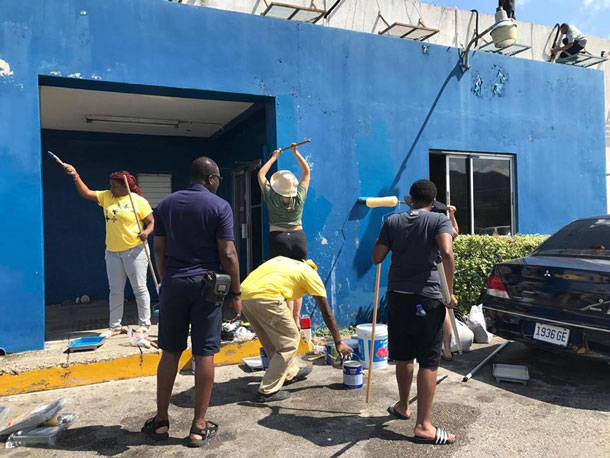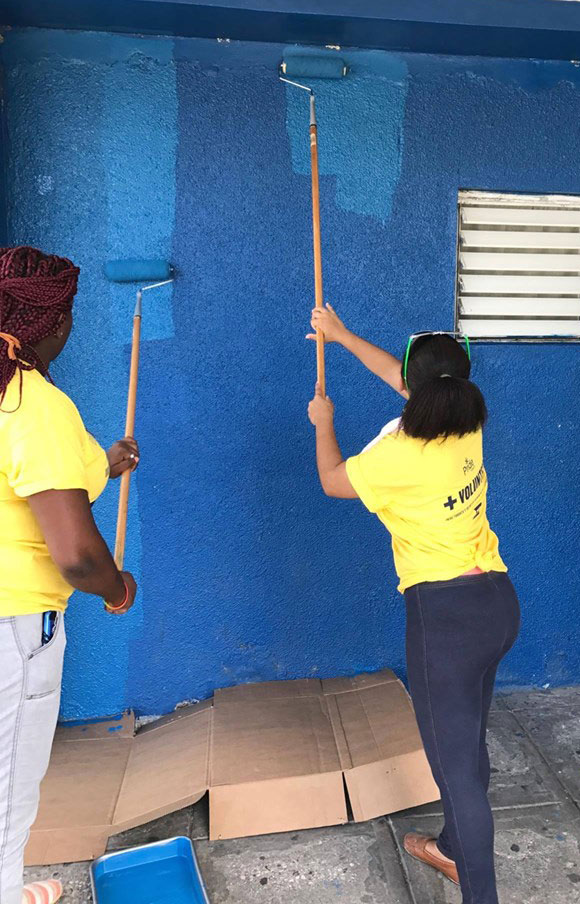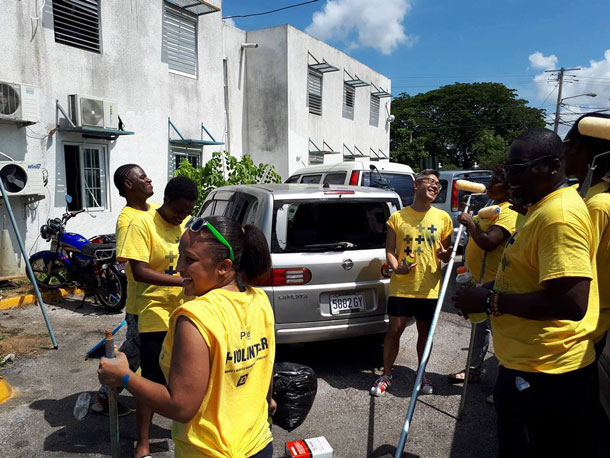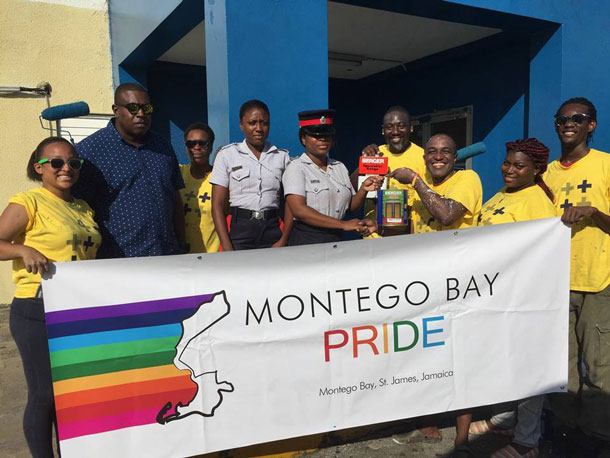LGBT Jamaicans paint their way closer to local police
Colin Stewart is a 45-year journalism veteran living in Southern…

“LGBT community members in Jamaica refuse to be victims. We are actively engaged in our own liberation,” says activist Maurice Tomlinson. This includes building — or painting — a bridge to often-homophobic local police.
LGBT Jamaicans painting a bridge to the police

In 2010 I received an email from a stranger who promised to kill me if I continued to advocate for LGBT human rights in Jamaica. These sorts of threats were and remain quite common and most LGBT activists on the island receive them. For the most part we usually document the threats and then largely ignore them as part of the cost of our activism.
However, the immediacy and vulgarity of the threat I received caused some of my colleague activists to insist that I go to the police and make a report. So, I visited the Freeport Police Station close to my home in Montego Bay to do just that.
As a lawyer I had often gone to police stations across Jamaica with LGBT individuals, either to make reports of homophobic attacks or to challenge police arbitrary use of anti-gay laws to persecute our community. This would be my first time making a report on my own behalf, but I thought that I knew what to expect. I was wrong.
After showing the officer the threat on my smart phone, he proceeded to tell me that he hated gays and that we make him sick. Nevertheless he promised that the investigation into the source of the emailed threat (a clear violation of our laws against sending threats electronically) would take only a week.
Weeks passed and despite frequent requests for an update on the investigation I received none. Eventually I reported the matter to an Assistant Commissioner of Police (ironically, a Briton who had been sent to Jamaica to help professionalize the police service) and he advised me that the situation was unfortunate but it would not change until the country’s 1864 anti-sodomy was repealed. Considering the fact that nearly 90% of Jamaicans support this law and the powerful churches have threatened to unseat any politician who supports repeal, the chances of ending this British colonially-imposed statue are very slim.

I therefore reported the matter to the Inter-American Commission on Human Rights (IACHR), which then issued the first-ever Precautionary Measure against a state on behalf of a defender of LGBT human rights. The IACHR found that I faced an immediate threat and required the Jamaican government to work with me to devise a protocol to ensure my safety. When I was eventually contacted by the Jamaican police to implement the Measure I asked that the sender of the email be identified so that I could verify the seriousness of the threat. This was never done. Needless to say I have been very wary of interacting with Jamaican police ever since my incident.
So, you can imagine my surprise when the planning team for Montego Bay Pride decided to paint the Freeport Police Station as this year’s social justice project! Each year a different institution serving the public is selected by Montego Bay Pride to receive a paint job as a way of instilling pride in their surroundings by clients and workers of the entity. The Freeport Police station is the busiest in the parish of St. James and is showing the signs of extensive use. The building has not been painted in years and shows it.
As the lead coordinator of Montego Bay Pride, I was asked to draft and hand-deliver the letter to the commanding officer (CO) of the station requesting permission to paint and I was less than thrilled at this request. The last time I spoke with a CO at Freeport was in 2009 when I had to do a solo sit-in on the premises because the station’s administrative office had “lost” four permit requests that I had submitted for a peaceful “Walk for Tolerance.”
Even after the CO verbally granting my permit, which included a request for police presence, no officer showed up on the day to provide security to our group of nearly 200 persons. I had to return to the station before the start of the Walk to insist that an officer be sent. In the end, we were provided with only one policeman on a motorbike who rode at the head of the Walk. In other words, he would have offered no effective security in case of any anti-gay attacks from our still very homophobic countrymen.
In light of my history with the police, I was not too keen on the idea of painting their place of work. I also know that the Freeport police are not too keen on LGBT people. So, when I drafted the paint request letter I used a large Montego Bay Pride rainbow banner as the letterhead, anticipating that our request would be denied.
When I delivered my letter, the CO asked only one question: “What sort of people will be doing the painting? People like you?” I told him yes. He said that he was very interested and would get back to me. Soon thereafter he advised, to my shock, that approval for the painting was granted.
So, on Saturday, Oct. 14 a group of twelve Montego Bay Pride volunteers turned up to paint the station and despite punishing heat we managed to provide a partial facelift to the building façade. A superintendent even arranged for some officers in uniform to take a picture with us and the rainbow Montego Bay Pride banner. The officers had been reluctant to do so at first.

The day was certainly transformational for many of us. We learnt to not judge an institution by the actions of some individuals. That said there is still a long way to go in repairing relationships between the police and Jamaica’s LGBT community. That is why uniformed officers are not asked to participate in our Pride events, because many of our members still feel traumatized by ongoing arbitrary police action.
However, the community is not waiting on the police to come to us. We are going to them. This includes offering to paint another section of the Freeport Police station for Montego Bay Pride 2018. For some years the police force has had an official written anti-discrimination policy that includes sexual orientation, but translating that policy into practice is taking much too long.
To address this urgent need, Montego Bay Pride has also proposed to deliver LGBT sensitivity training to the officers at Freeport . The Canadian HIV/AIDS Legal Network, where I work, has been a key sponsor of Montego Bay Pride since its inception and has also delivered this award-winning training in seven other Caribbean countries. I am hoping that we can bring this training to my hometown before next Pride.
LGBT community members in Jamaica refuse to be victims. We are actively engaged in our own liberation and this includes building or painting a bridge to an institution that traditionally oppressed us.
Previous articles about Montego Bay Pride 2017:
- Jamaica: Pride is a living legacy of the LGBTI movement (October 2017, 76crimes.com)
- Montego Bay Pride: Break ‘the mental chains’ imposed on us by Asheen Walford (September 2017, 76crimes.com)
- Montego Bay Pride: ‘We won’t be in hiding any more’ by David Alexander Green (August 2017, 76crimes.com)
- Jamaica celebrates twice: Pride, then more Pride, commentary provided by Khavor Demario Brown (August 2017, 76crimes.com)
- A reason for Montego Bay Pride: Murder of trans youth
by Maurice Tomlinson (
Related articles:
- Jamaica needs more Pride, more often (December 2016, 76crimes.com)
- How was Montego Bay Pride a success? Let me count the ways (October 2016, 76crimes.com)
- Jamaican success: Fun + advocacy at Montego Bay Pride (October 2016, 76crimes.com)
- Deliriously happy after Jamaica’s first Montego Bay Pride (October 2015, 76crimes.com)
- Jamaica’s first Pride gets boost from government officials (August 2015, 76crimes.com)
- Why Jamaica Pride 2015 matters (Aug. 4, 2015, Jamaica Observer)
- Montego Bay Pride – here’s why (August 2015, 76crimes.com)
- Commentary: Why Jamaica Pride is important (August 2015, 76crimes.com)




